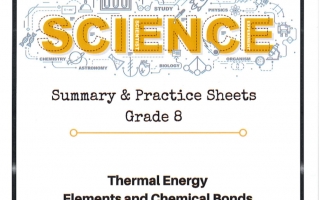SCIENCE
Summary & Practice Sheets
Grade 8
Thermal Energy Elements and Chemical Bonds Chemical Reactions and Equations Electricity and Magnetism
HOT OR COLD
WORD BANK
Temperature: the average kinetic energy of the particles
Heat: the transfer of energy from hot to cold
Thermal Energy: the sum of kinetic and potential energy of the particles
Thermal energy can be transferred by
conduction
energy is transferred by direct contact
convection
energy is transferred by the motion of particles
radiation
energy is transferred by waves
thermal conductor
material that allows heat energy to be transferred
thermal insulator
material that does not allow heat energy to be transferred
Revision Sheets
Chapter 1-Thermal Energy
Part A- True/False
Indicate whether the statement is true or false.
1. Potential energy is the energy of motion.
2. Thermal energy is the temperature of the particles in a material.
3. Temperature is a measure of the average kinetic energy of all the particles in an object.
4. Heat is the movement of kinetic energy from a warmer object to a cooler object.
5. The tool that is used for measuring temperature is called a ammeter.
6. The temperature at which all particle movement stops is 373 K.
Part B- Multiple Choice
Identify the choice that best completes the statement or answers the question.
7. Which of the following objects has kinetic energy?
a. a bicycle parked at the top of a hill
b. leaves on the ground beneath a tree
c. a football rolling across a field
d. a sunny windowsill
8. Which increases the kinetic energy of the particles in a bowl of soup?
a. dividing the soup in half
b. putting the soup in the refrigerator
c. heating the soup for one minute on the stove
d. decreasing the distance between the particles that make up the soup
9. What do convection and conduction have in common?
a. they can both transfer thermal energy from one material to another.
b. they can both occur in solids, liquids, and gases.
c. they both produce currents
d. they both involve the movement of particles
10. Why is radiation the only way heat is transferred from the Sun to the Earth?
a. because particles cannot move in the sun
b. because particles cannot move on earth
c. because it is the only kind of heat transfer that can occur in a vacuum
d. because it is the only kind of heat transfer that can occur over a large distance
11. Which is the transfer of thermal energy by the motion of heated particles in a gas or liquid from one part of a material to another?
a. conduction
b. radiation
c. convection
d. collision
12. Which is an increase in the size of a substance when the temperature is increased?
a. diffusion
b. thermal expansion
c. thermal contraction
d. specific heat
13. Which energy conversion typically occurs in a heating appliance?
a. chemical energy to thermal energy
b. electric energy to thermal energy
c. thermal energy to chemical energy
d. thermal energy to mechanical energy
14. Which of the following statements about thermal energy transfer is true?
a. When heat is transferred by conduction, particles collide but remain in the same location.
b. Convection takes place most easily in solids.
c. The Sun is the only source of radiation.
d. Convection does not occur naturally.
Part C- Matching
Match each term with its correct description
a. thermal energy
b. temperature
c. heat
d. radiation
e. conduction
f. convection
g. thermostat
h. thermal contraction
i. specific heat
15. The average kinetic energy of the particles that make up a material.
16. The sum of the kinetic energy and the potential energy of the particles that make up a material.
17. The movement of thermal energy from a warmer object to a cooler object.
18. The amount of thermal energy required to increase the temperature of 1kg of a material by 1° C.
19. A decrease in a material's volume when the temperature decreases.
20. The transfer of thermal energy by the movement of particles from one part of a material to another.
21. The transfer of thermal energy between materials by the collisions of particles.
22. The transfer of thermal energy from one material to another by electromagnetic waves.
23. A device that regulates the temperature of a system.
Part D- Short Answer
Write the correct answer for each of the following questions.
24. Explain how thermal energy and temperature differ.
25. Identify one material that is a good thermal conductor and one material that is a good thermal insulator.
26. What is a thermostat? List three appliances that are equipped with thermostats.
27. How does a refrigerator keep food cold?
28. What are the energy transformations in a car engine?
Part E- Organizing
Complete the table by writing each phrase or statement under the correct heading, Each phrase or statement is used only once. Some examples have been done for you.
• All matter radiates thermal energy.
• involves the movement of thermal energy in a liquid
• occurs in fluids
• the transfer of thermal energy between materials because of collisions between the particles
• the transfer of thermal energy from one material to another by electromagnetic waves
• When particles with different kinetic energies collide, the particles with higher kinetic energy transfer energy to particles with lower kinetic energy
Radiation
Meaning:
A car receives thermal energy from the sun through this.
Conduction
Meaning:
Continues until the thermal energy of all particles in contact is equal.
Convection
Meaning: The transfer of thermal energy by the movement of particles from one part of a material to another.
ATOMS: the unit of matter
first shell holds a maximum of 2 electrons
third shell holds a maximum of 8 electrons
second shell holds a maximum of 8 electrons
valence electron is an outermost electron
COMPOUNDS
covalent
two or more nonmetals share valence electrons
ionic
metal transfers valence electrons to a nonmetal
metallic
metals share pooled valence electrons
Representing Compounds
PRACTICE-COMPOUNDS
Label the following compounds with the correct model.
CHARGING TIME!
( - ) Electrons have a negative charge.
( + ) Protons have a positive charge.
PRACTICE-CALCULATING CHARGE
1. 4 - 10 =
2. (-8) + 15 =
3. 9 + (-10) =
4. 13 + (-10) =
5. 0 + (-15) =
6. 10 + (-10) =
7. Magnesium has 12 protons and 12 electrons. What will its charge be when it loses 2 electrons?





